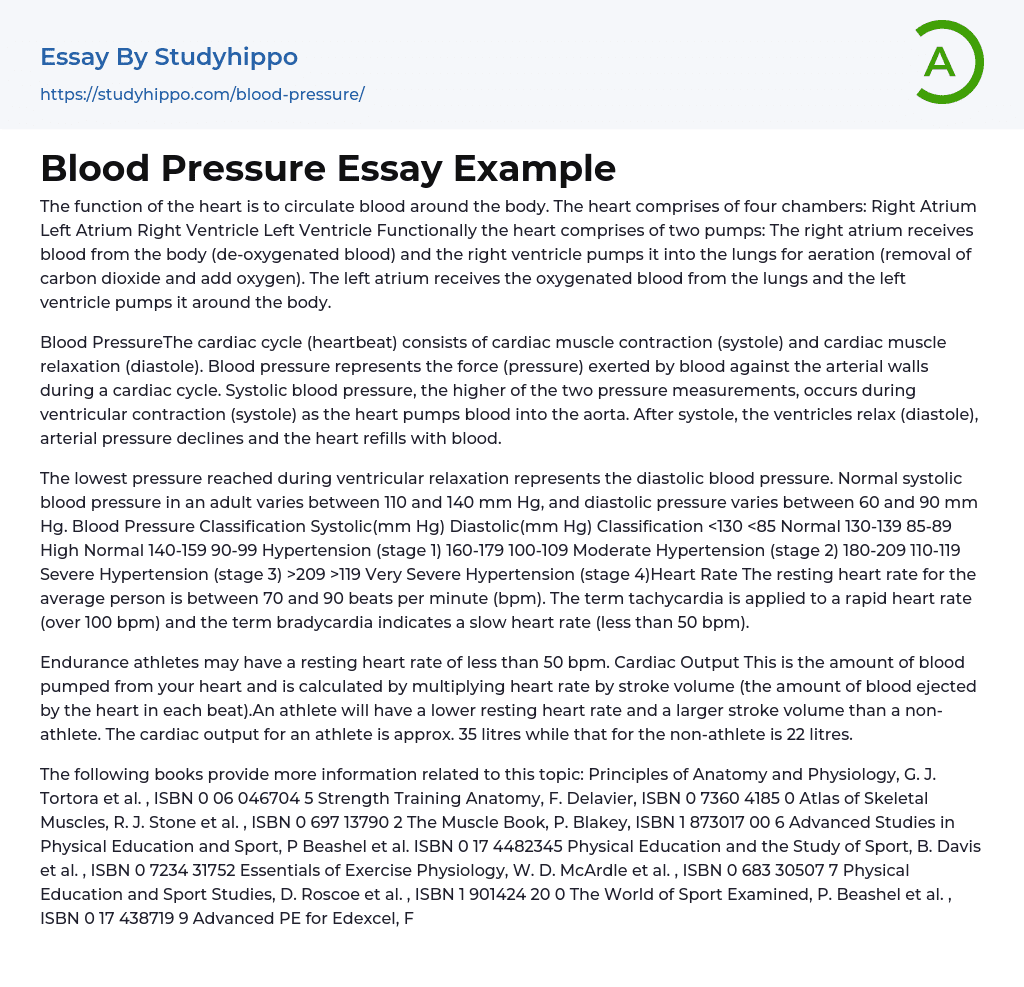The function of the heart is to circulate blood around the body. The heart comprises of four chambers: Right Atrium Left Atrium Right Ventricle Left Ventricle Functionally the heart comprises of two pumps: The right atrium receives blood from the body (de-oxygenated blood) and the right ventricle pumps it into the lungs for aeration (removal of carbon dioxide and add oxygen). The left atrium receives the oxygenated blood from the lungs and the left ventricle pumps it around the body.
Blood PressureThe cardiac cycle (heartbeat) consists of cardiac muscle contraction (systole) and cardiac muscle relaxation (diastole). Blood pressure represents the force (pressure) exerted by blood against the arterial walls during a cardiac cycle. Systolic blood pressure, the higher of the two pressure measurements, occurs during ventricular contraction (systole) as the heart pumps blood into the aorta. After systole, the ven
...tricles relax (diastole), arterial pressure declines and the heart refills with blood.
The lowest pressure reached during ventricular relaxation represents the diastolic blood pressure. Normal systolic blood pressure in an adult varies between 110 and 140 mm Hg, and diastolic pressure varies between 60 and 90 mm Hg. Blood Pressure Classification Systolic(mm Hg) Diastolic(mm Hg) Classification <130 <85 Normal 130-139 85-89 High Normal 140-159 90-99 Hypertension (stage 1) 160-179 100-109 Moderate Hypertension (stage 2) 180-209 110-119 Severe Hypertension (stage 3) >209 >119 Very Severe Hypertension (stage 4)Heart Rate The resting heart rate for the average person is between 70 and 90 beats per minute (bpm). The term tachycardia is applied to a rapid heart rate (over 100 bpm) and the term bradycardia indicates a slow heart rate (less than 50 bpm).
Endurance athletes may have a resting heart rate
of less than 50 bpm. Cardiac Output This is the amount of blood pumped from your heart and is calculated by multiplying heart rate by stroke volume (the amount of blood ejected by the heart in each beat).An athlete will have a lower resting heart rate and a larger stroke volume than a non-athlete. The cardiac output for an athlete is approx. 35 litres while that for the non-athlete is 22 litres.
The following books provide more information related to this topic: Principles of Anatomy and Physiology, G. J. Tortora et al. , ISBN 0 06 046704 5 Strength Training Anatomy, F. Delavier, ISBN 0 7360 4185 0 Atlas of Skeletal Muscles, R. J. Stone et al. , ISBN 0 697 13790 2 The Muscle Book, P. Blakey, ISBN 1 873017 00 6 Advanced Studies in Physical Education and Sport, P Beashel et al. ISBN 0 17 4482345 Physical Education and the Study of Sport, B. Davis et al. , ISBN 0 7234 31752 Essentials of Exercise Physiology, W. D. McArdle et al. , ISBN 0 683 30507 7 Physical Education and Sport Studies, D. Roscoe et al. , ISBN 1 901424 20 0 The World of Sport Examined, P. Beashel et al. , ISBN 0 17 438719 9 Advanced PE for Edexcel, F. Galligan et al. , ISBN 0 435 50643 9 Examining Physical Education, K. Bizley, ISBN 0 435 50660 9 Sport and PE, K Wesson et al. , ISBN 0 340 683821 PE for you, J. Honeybourne, ISBN 0 7487 3277 2
- Action Potential essays
- Blood essays
- Body essays
- Brain essays
- Childbirth essays
- Eye essays
- Glucose essays
- Heart essays
- Human Physiology essays
- Immune System essays
- Kidney essays
- Muscle essays
- Nervous System essays
- Neuron essays
- Poison essays
- Puberty essays
- Sense essays
- Skeleton essays
- Skin essays
- Atom essays
- Big Bang Theory essays
- Density essays
- Electricity essays
- Energy essays
- Force essays
- Heat essays
- Light essays
- Motion essays
- Nuclear Power essays
- Physiology essays
- Sound essays
- Speed essays
- Temperature essays
- Thermodynamics essays
- Ambition essays
- Anger essays
- Betrayal essays
- Boredom essays
- Confidence essays
- Courage essays
- Desire essays
- Disgrace essays
- Doubt essays
- Empathy essays
- Fairness essays
- Fear essays
- Feeling essays
- Forgiveness essays
- Grief essays
- Guilt essays




